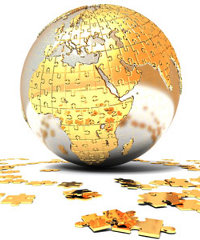 Standard Bank analyst Simon Freemantle has identified five
key trends that will propel Africa’s ongoing economic reinvigoration in
the next four decades.
Standard Bank analyst Simon Freemantle has identified five
key trends that will propel Africa’s ongoing economic reinvigoration in
the next four decades.
“Naturally Africa’s sheer size as well as often vastly differing
economic and political dynamics . . . renders generalisation
problematic. However, the broad thrust of these trends is incorporating
the majority of the continent’s emerging and aspiring economies,” says
Freemantle.
The five trends are:
Trend 1: A larger, younger and more affluent population
Africa’s population growth will average 2.2% over the next decade,
compared to 0.9% in Asia. It is expected that Africa will have a
population of almost 2 billion by 2050. Rapid population growth also
means that the populace is exceptionally young. Sub-Saharan Africa’s
median is age 18.6, compared to 32 for the BRIC countries.
Coupled with strong economic growth, population growth will support
the emergence of the continent’s consumer base. Consumer growth is being
supported by a rising middle class. According to Freemantle, around 150
million Africans have entered the middle class since 1990, with a
further 40 million households to become middle class by 2015.
Trend 2: Africa’s transformational urban swell
It is estimated that about 40% of Africans currently live in urban
areas. By 2050 more than 60% of the continent’s population will be
urbanised. Nigeria will see 140 million new urban entrants in the next
40 years. Countries such as South Africa and Angola will be more than
80% urbanised by 2050. Although this will lead to an influx of people
into megacities such as Lagos, Kinshasa and Cairo, 70% of all urban
growth in the next two decades will take place in smaller towns and
cities.
Trend 3: Leapfrogging through technology
Africa’s population has vigorously embraced technology in general,
and telecommunications in particular, as a means to boost socio-economic
prosperity. By the end of 2010, there were over 500 million mobile
subscriptions in Africa; by 2015, it is expected there will be almost
800 million. Nigeria is already the world’s tenth-largest mobile market.
More Africans are also connecting to the internet. While internet
penetration is still relatively low (around 120 million users) growth
rates have been profound. Internet costs remain excessively high,
limiting uptake. A range of mostly private-funded fibre optic cables set
to land, or having already landed, on Africa’s east and west coasts are
set to lower costs for African internet users.
Trend 4: Africa’s dormant resources potential
In addition to Africa’s considerable precious and base metals wealth,
the continent is becoming a more important player in the world’s energy
markets. At the end of 2010, Africa had 9.5% of the world’s crude oil,
and 8% of the world’s natural gas reserves. The continent, however,
still holds considerable untapped reserves, with recent discoveries in
Ghana, Uganda and potentially Namibia attracting strong interest.
Meanwhile, with food anticipated to become the “new oil” of the 21st
century, Africa’s immense and largely dormant, agricultural potential is
gaining elevated attention. In order to feed the world’s population in
2050, food production will have to increase by 70%, necessitating a
total average investment in developing world agriculture of US$83
billion.
Trend 5: Africa’s deepening financial sector
The financial services sector is responding rapidly to the
continent’s altering economic reality. Although the majority of Africans
remain locked out of the financial system, the growth projections for
the sector are stellar. At current growth rates, Africa’s financial
services sector could make up around 20% of the continent’s collective
GDP within the next decade, compared to 10% today. Much of the new
growth will come from retail banking. The expansion of financial
services has the ability to create new jobs, establish a formal identity
of millions of market participants, and provide greater safety than
predominant cash-based systems.
No comments:
Post a Comment